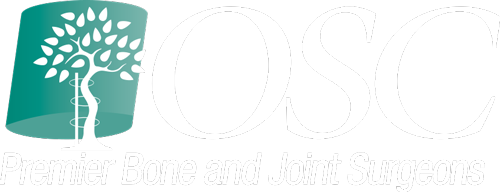We’re going to take a look at all the tools and treatments available at OSC’s on-site physical therapy facility. Next up: warm-up and stretching equipment and tools.
Warm-up
Warming up your body properly improves the benefits of physical therapy while also preventing further injury. Warming up gradually increases heart rate, which increases blood flow, oxygen, and body temperature, which increases muscle extensibility. Here are some of the warm-up equipment you may encounter during a physical therapy session at OSC.
Treadmill with Full Rails and Reverse
A treadmill with full rails allows for support while walking, if needed. Reverse settings allow the user to work on balance, coordination, and strengthening postural muscles. Speed and incline can be adjusted to vary intensity level.
Trimline Elliptical Runner Machine
Elliptical machines offer a lower impact method of warming up, while also engaging the upper body as well. Resistance can be raised and lowered to vary the intensity of the warm-up.
Cycling
Cycling is a low impact exercise, ideal for helping to restore and improve knee joint stability and strength. At OSC, both an upright stationary bike and a recumbent stationary bike are available.
Upright Stationary Bike
An upright stationary bike positions the pedals beneath your hips and requires more knee flexibility than a recumbent bike. Because more stabilization is needed when riding, an upright bike also engages core muscles and the upper body as you pedal.
Recumbent Bike
Recumbent bikes position your upper body in a semi-reclined alignment, with your legs out in front and takes more weight off of your joints. It is more low impact than an upright bike.
Upper Body Ergometer
Upper body ergometers work similarly to stationary bicycles, but are used with the upper body. Patients “pedal” the machine with their arms. This is especially beneficial equipment for patients who are working to improve strength and flexibility in their shoulders.
Stretching
Stretching is important in regaining range of motion in your joints after surgery. OSC’s on-site therapy facility has many stretching regimens and tools available.
Passive and Active Assistive Stretching
Passive stretching means that the affected joint is moved through its range of motion by mechanical means, gravity, or by another person with no effort by the patient. Active assistive stretching means that the patient moves the affected joint through its range of motion with the assistance of equipment, or a therapist, or both. Tools that aid the patient and physical therapist in these stretches include therapy balls, pulley systems, upper extremity rangers, and pull-up bars.
Dynamic Splinting (JAS/SPS) System for Range of Motion
With dynamic splinting, the affected joint is put into a stretched position with a JAS SPS (Static Progressive Stretch) device and held for several minutes. During that time, the surrounding tissues are given time to relax and lengthen. The splint is then adjusted to stretch the joint further, and the process is repeated. Range of motion of the joint is improved through this process.
At OSC, we’re dedicated to providing our patients with the most comprehensive orthopaedic care available. We’re the only orthopaedic clinic in the Inland Northwest with its own dedicated therapy facilities. If you’re in need of care, make an appointment today and find out the OSC difference.
